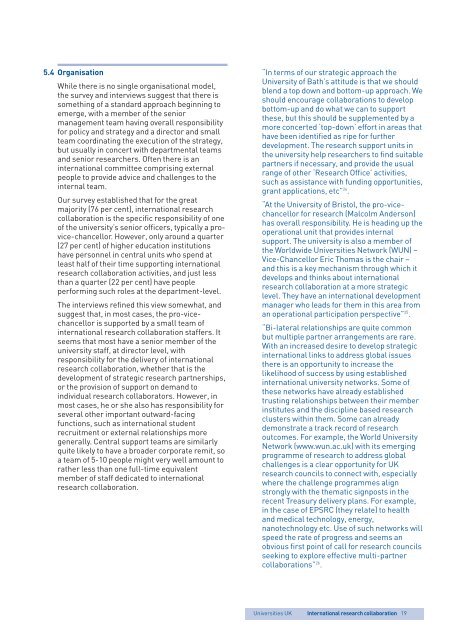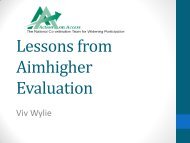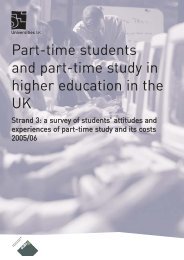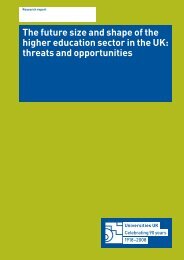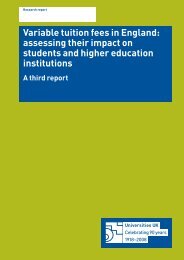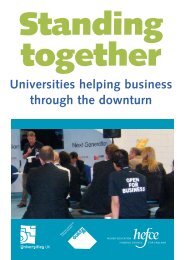International Research Collaboration - GlobalHigherEd
International Research Collaboration - GlobalHigherEd
International Research Collaboration - GlobalHigherEd
Create successful ePaper yourself
Turn your PDF publications into a flip-book with our unique Google optimized e-Paper software.
5.4 OrganisationWhile there is no single organisational model,the survey and interviews suggest that there issomething of a standard approach beginning toemerge, with a member of the seniormanagement team having overall responsibilityfor policy and strategy and a director and smallteam coordinating the execution of the strategy,but usually in concert with departmental teamsand senior researchers. Often there is aninternational committee comprising externalpeople to provide advice and challenges to theinternal team.Our survey established that for the greatmajority (76 per cent), international researchcollaboration is the specific responsibility of oneof the university’s senior officers, typically a provice-chancellor.However, only around a quarter(27 per cent) of higher education institutionshave personnel in central units who spend atleast half of their time supporting internationalresearch collaboration activities, and just lessthan a quarter (22 per cent) have peopleperforming such roles at the department-level.The interviews refined this view somewhat, andsuggest that, in most cases, the pro-vicechancelloris supported by a small team ofinternational research collaboration staffers. Itseems that most have a senior member of theuniversity staff, at director level, withresponsibility for the delivery of internationalresearch collaboration, whether that is thedevelopment of strategic research partnerships,or the provision of support on demand toindividual research collaborators. However, inmost cases, he or she also has responsibility forseveral other important outward-facingfunctions, such as international studentrecruitment or external relationships moregenerally. Central support teams are similarlyquite likely to have a broader corporate remit, soa team of 5-10 people might very well amount torather less than one full-time equivalentmember of staff dedicated to internationalresearch collaboration.“In terms of our strategic approach theUniversity of Bath’s attitude is that we shouldblend a top down and bottom-up approach. Weshould encourage collaborations to developbottom-up and do what we can to supportthese, but this should be supplemented by amore concerted ‘top-down’ effort in areas thathave been identified as ripe for furtherdevelopment. The research support units inthe university help researchers to find suitablepartners if necessary, and provide the usualrange of other ‘<strong>Research</strong> Office’ activities,such as assistance with funding opportunities,grant applications, etc” 24 .“At the University of Bristol, the pro-vicechancellorfor research (Malcolm Anderson)has overall responsibility. He is heading up theoperational unit that provides internalsupport. The university is also a member ofthe Worldwide Universities Network (WUN) –Vice-Chancellor Eric Thomas is the chair –and this is a key mechanism through which itdevelops and thinks about internationalresearch collaboration at a more strategiclevel. They have an international developmentmanager who leads for them in this area froman operational participation perspective” 25 .“Bi-lateral relationships are quite commonbut multiple partner arrangements are rare.With an increased desire to develop strategicinternational links to address global issuesthere is an opportunity to increase thelikelihood of success by using establishedinternational university networks. Some ofthese networks have already establishedtrusting relationships between their memberinstitutes and the discipline based researchclusters within them. Some can alreadydemonstrate a track record of researchoutcomes. For example, the World UniversityNetwork (www.wun.ac.uk) with its emergingprogramme of research to address globalchallenges is a clear opportunity for UKresearch councils to connect with, especiallywhere the challenge programmes alignstrongly with the thematic signposts in therecent Treasury delivery plans. For example,in the case of EPSRC (they relate) to healthand medical technology, energy,nanotechnology etc. Use of such networks willspeed the rate of progress and seems anobvious first point of call for research councilsseeking to explore effective multi-partnercollaborations” 26 .Universities UK<strong>International</strong> research collaboration 19


